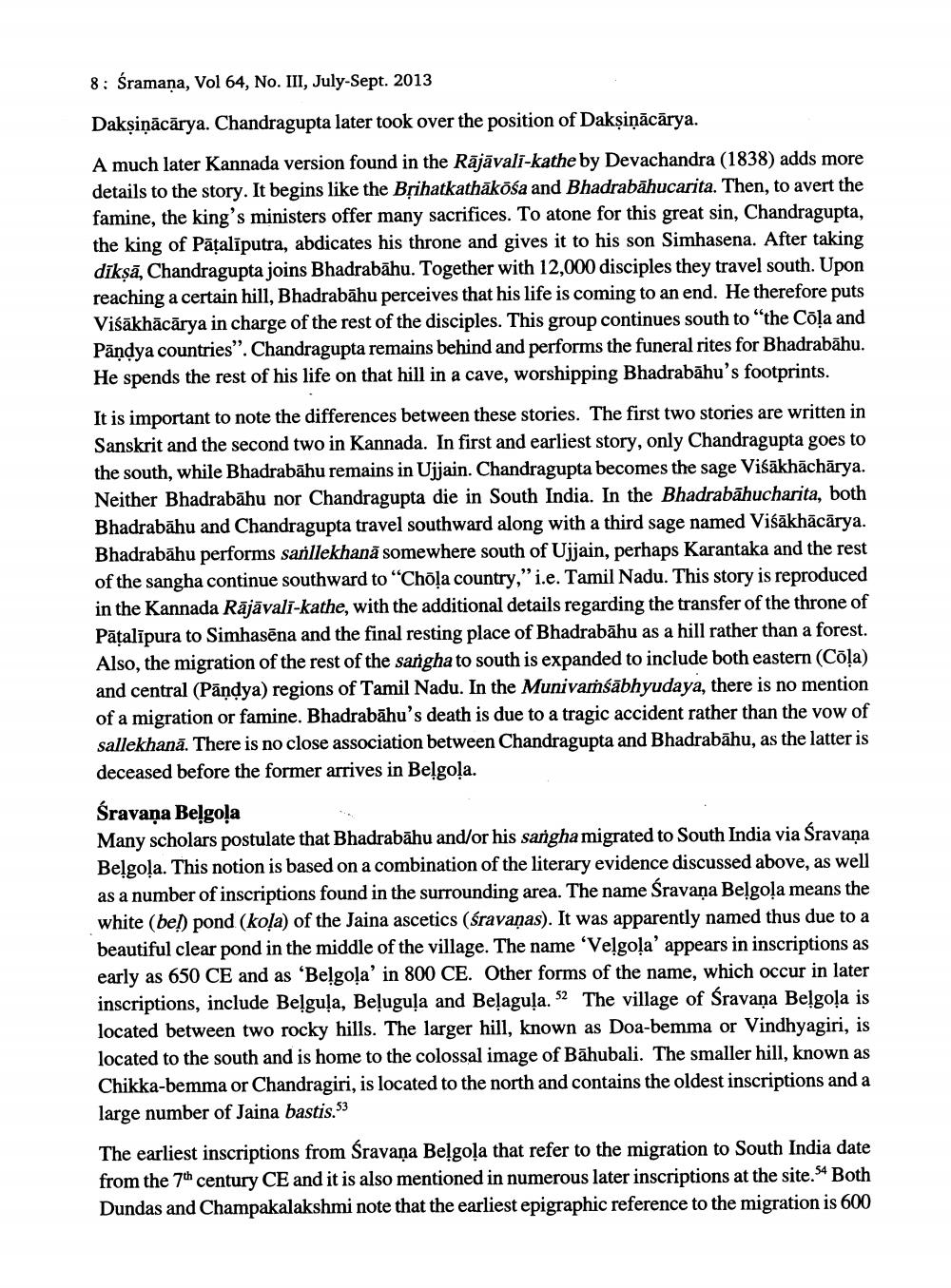________________
8: śramana, Vol 64, No. III, July-Sept. 2013
Dakṣiṇācārya. Chandragupta later took over the position of Dakṣiṇācārya. A much later Kannada version found in the Rājāvali-kathe by Devachandra (1838) adds more details to the story. It begins like the Brihatkathākośa and Bhadrabāhucarita. Then, to avert the famine, the king's ministers offer many sacrifices. To atone for this great sin, Chandragupta, the king of Pāšalīputra, abdicates his throne and gives it to his son Simhasena. After taking dikṣā, Chandragupta joins Bhadrabāhu. Together with 12,000 disciples they travel south. Upon reaching a certain hill, Bhadrabāhu perceives that his life is coming to an end. He therefore puts Viśākhācārya in charge of the rest of the disciples. This group continues south to "the Cola and Pandya countries”. Chandragupta remains behind and performs the funeral rites for Bhadrabāhu. He spends the rest of his life on that hill in a cave, worshipping Bhadrabāhu's footprints. It is important to note the differences between these stories. The first two stories are written in Sanskrit and the second two in Kannada. In first and earliest story, only Chandragupta goes to the south, while Bhadrabāhu remains in Ujjain. Chandragupta becomes the sage Viśākhāchārya. Neither Bhadrabāhu nor Chandragupta die in South India. In the Bhadrabāhucharita, both Bhadrabāhu and Chandragupta travel southward along with a third sage named Višākhācārya. Bhadrabāhu performs sanllekhanā somewhere south of Ujjain, perhaps Karantaka and the rest of the sangha continue southward to “Chola country," i.e. Tamil Nadu. This story is reproduced in the Kannada Rājāvali-kathe, with the additional details regarding the transfer of the throne of Pāțalīpura to Simhasēna and the final resting place of Bhadrabāhu as a hill rather than a forest. Also, the migration of the rest of the sangha to south is expanded to include both eastern (Cõļa) and central (Pāndya) regions of Tamil Nadu. In the Munivaṁsābhyudaya, there is no mention of a migration or famine. Bhadrabāhu's death is due to a tragic accident rather than the vow of sallekhanā. There is no close association between Chandragupta and Bhadrabāhu, as the latter is deceased before the former arrives in Belgoļa.
Śravaņa Belgoļa Many scholars postulate that Bhadrabāhu and/or his sangha migrated to South India via Śravaņa Belgoļa. This notion is based on a combination of the literary evidence discussed above, as well as a number of inscriptions found in the surrounding area. The name Śravaņa Belgoļa means the white (bel) pond (kola) of the Jaina ascetics (śravaņas). It was apparently named thus due to a beautiful clear pond in the middle of the village. The name 'Velgola' appears in inscriptions as early as 650 CE and as 'Belgoļa' in 800 CE. Other forms of the name, which occur in later inscriptions, include Belguļa, Beļuguļa and Belaguļa. 52 The village of Śravaņa Belgoļa is located between two rocky hills. The larger hill, known as Doa-bemma or Vindhyagiri, is located to the south and is home to the colossal image of Bāhubali. The smaller hill, known as Chikka-bemma or Chandragiri, is located to the north and contains the oldest inscriptions and a large number of Jaina bastis.53 The earliest inscriptions from Śravaņa Belgola that refer to the migration to South India date from the 7th century CE and it is also mentioned in numerous later inscriptions at the site. 54 Both Dundas and Champakalakshmi note that the earliest epigraphic reference to the migration is 600




